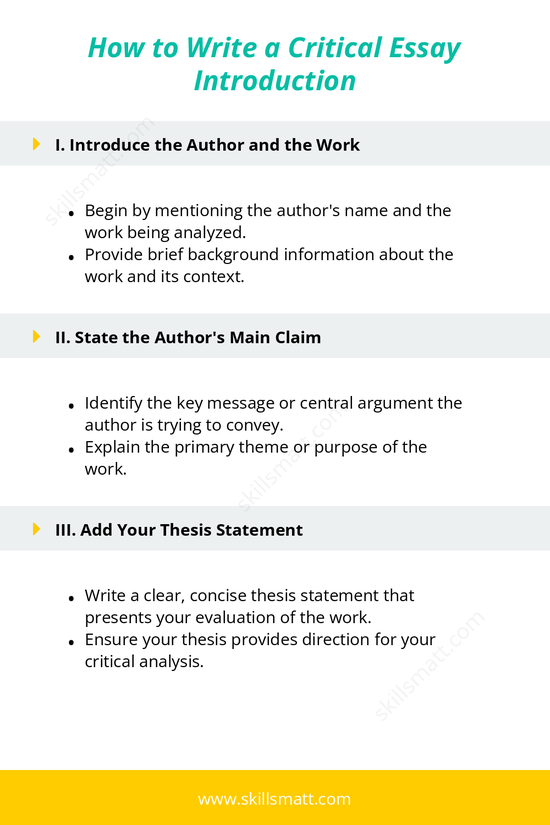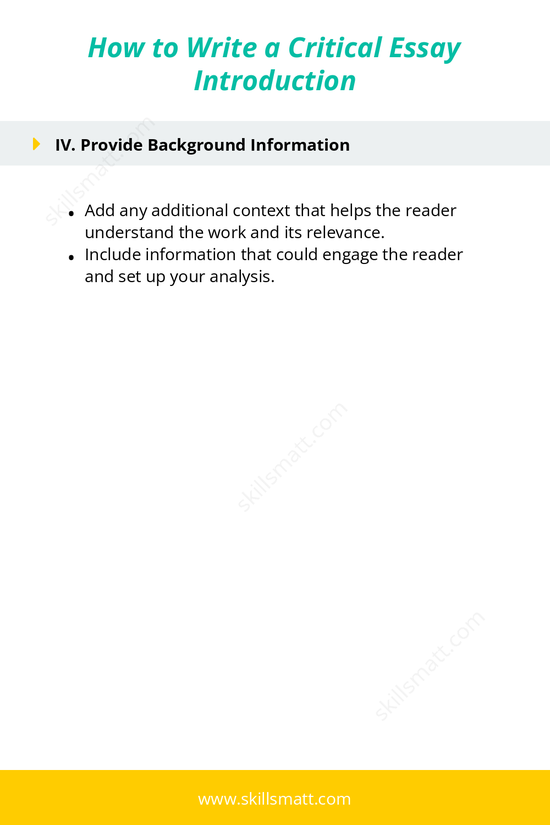How to Write a Critical Essay Introduction
I. Introduce the Author and the Work
- Begin by mentioning the author’s name and the work being analyzed: Start your introduction by stating the author’s name and the title of the work you are analyzing. This gives the reader context for your analysis and sets the stage for your critical evaluation.
- Provide brief background information about the work and its context: Offer any relevant background details that will help the reader understand the work's significance, such as when it was written, its genre, or its place in literary history. For instance, mention whether the work is part of a specific literary movement, or how it fits within the author’s broader body of work.
II. State the Author's Main Claim
- Identify the key message or central argument the author is trying to convey: Discuss the main idea or argument the author presents in the work. This will help frame your analysis of the work’s effectiveness and meaning. Is the author advocating for a particular perspective or exploring a universal theme?
- Explain the primary theme or purpose of the work: Identify and explain the major themes or purposes the author is addressing, whether it's a social issue, a personal experience, or a universal truth. For example, does the work explore themes of morality, identity, or justice? Understanding this will provide context for your critical analysis.
III. Add Your Thesis Statement
- Write a clear, concise thesis statement that presents your evaluation of the work: Your thesis statement should outline your judgment or evaluation of the work, highlighting what aspects you will focus on in your analysis. This statement sets the tone for the entire essay and indicates your position on the work’s merit.
- Ensure your thesis provides direction for your critical analysis: The thesis should guide the structure of your essay and provide the reader with a clear understanding of your perspective on the work. Will you be analyzing the author’s use of symbolism, character development, narrative structure, or overall message?
IV. Provide Background Information
- Add any additional context that helps the reader understand the work and its relevance: Provide context that could help the reader engage with the work’s themes or better understand its significance. This might include historical or cultural context or brief explanations of complex ideas. For instance, if the work was written during a particular political movement or social upheaval, it may be important to mention how those influences shaped the author's message.
- Include information that could engage the reader and set up your analysis: The introduction should hook the reader and motivate them to continue reading. Consider using an intriguing question, a thought-provoking quote from the text, or a surprising piece of information that invites the reader to explore your argument. An effective hook grabs the reader’s attention and encourages them to delve deeper into your analysis.
V. Conclude Your Introduction with a Roadmap for the Essay
- Give a brief outline of how you will organize your critical essay: Before diving into your analysis, offer a brief roadmap of your essay’s structure. Let the reader know what to expect in the following sections. For instance, will you start with an analysis of the author’s writing style, followed by an examination of the themes and characters? Offering this roadmap helps set expectations and prepares the reader for the flow of your argument.
- Reaffirm the significance of the work: End your introduction by reaffirming the significance of the work in its literary or cultural context. Why is it worth analyzing, and how does it contribute to the broader conversation? This will solidify the importance of your critique and set the stage for a detailed and engaging essay.
By following these steps, you can craft a compelling introduction that not only introduces the work you are analyzing but also engages the reader with a thoughtful evaluation that sets the stage for the rest of your critical essay.


